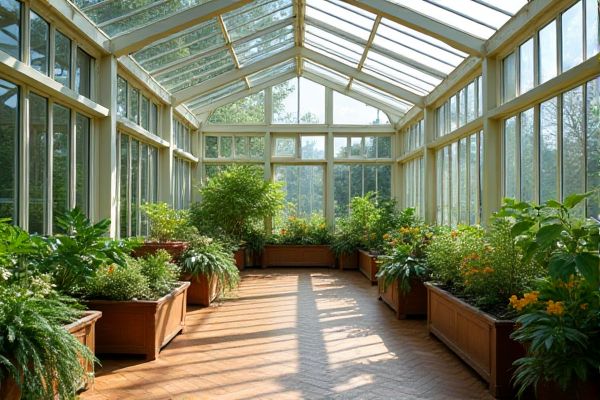
A sunroom provides a comfortable, climate-controlled space for relaxation and enjoying natural light, while a greenhouse is specifically designed to create optimal conditions for growing plants year-round. Explore the rest of the article to discover which option best suits your needs and lifestyle.
Table of Comparison
| Feature | Sunroom | Greenhouse |
|---|---|---|
| Purpose | Living space extension, relaxation area | Plant cultivation, climate control for growth |
| Structure | Insulated walls and windows, typically attached to home | Glass or polycarbonate panels, designed for maximum sunlight |
| Temperature Control | Heated or cooled for comfort | Maintains warm, humid environment for plants |
| Uses | Lounging, dining, socializing | Growing flowers, vegetables, and tropical plants |
| Ventilation | Standard windows and HVAC systems | Special vents or automated systems for airflow |
| Lighting | Natural sunlight plus artificial lighting | Maximizes natural light; often supplemented by grow lights |
| Cost | Higher due to insulation and finishes | Varies; usually lower but depends on size and materials |
Introduction to Sunrooms and Greenhouses
Sunrooms provide a versatile living space with large windows that invite natural light, enhancing your home's comfort and ambiance. Greenhouses are specialized structures designed to create controlled environments for growing plants year-round, optimizing temperature and humidity levels. Understanding the differences helps you choose the right addition based on your goals for leisure or horticulture.
Purpose and Functionality Differences
Sunrooms serve as comfortable living spaces that enhance natural light and outdoor views while providing weather protection, making them ideal for relaxation and entertainment. Greenhouses are specifically designed environments that control temperature, humidity, and light to optimize plant growth and extend growing seasons. Unlike sunrooms, greenhouses prioritize horticultural functionality over human comfort.
Structural Design and Materials
Sunrooms typically feature insulated glass panels, robust framing materials like aluminum or vinyl, and a sealed structure designed for year-round comfort and energy efficiency. Greenhouses use lightweight, transparent materials such as polycarbonate or greenhouse glass combined with metal or wood frames, optimized for maximum light transmission and humidity control to support plant growth. The structural design of sunrooms prioritizes thermal insulation and weather resistance, while greenhouses emphasize ventilation and durability under variable environmental conditions.
Climate Control and Insulation
Sunrooms typically feature insulated glass and framing to maintain comfortable indoor temperatures year-round, providing moderate climate control suitable for relaxation and living space. Greenhouses use specialized glazing materials and ventilation systems designed to optimize temperature, humidity, and light conditions for plant growth, often requiring additional heating or cooling mechanisms. The insulation in sunrooms prioritizes energy efficiency and comfort, whereas greenhouses emphasize creating a controlled environment tailored to botanical needs.
Lighting and Sunlight Utilization
Sunrooms are designed with large windows and skylights to maximize natural light for relaxation and indoor plants, while greenhouses use specialized glass or plastic panels to optimize sunlight intensity and diffusion for plant growth. Greenhouses often incorporate shading systems and ventilation to control temperature and light exposure, ensuring ideal conditions for photosynthesis. Your choice depends on whether you prioritize ambient natural light for living space or controlled, enhanced sunlight for cultivating plants.
Plant Growing Capabilities
Sunrooms offer controlled indoor environments with filtered sunlight suitable for growing houseplants and tropical varieties, but they lack the specialized climate control systems found in greenhouses. Greenhouses are specifically designed to optimize plant growth through regulated temperature, humidity, and ventilation, allowing for year-round cultivation of a wider range of plants, including delicate seedlings and vegetables. Enhanced light diffusion and automated irrigation in greenhouses significantly improve plant growth rates and health compared to sunrooms.
Living Space and Comfort
A sunroom extends your living space by providing a comfortable, climate-controlled environment ideal for relaxation and entertaining year-round with ample natural light. Greenhouses are primarily designed for plant growth, featuring controlled humidity and temperature but often lacking insulation and comfort for human use. Choosing a sunroom enhances your home's usable area and comfort, while a greenhouse serves as a specialized space focused on cultivating plants.
Maintenance and Upkeep
Sunrooms typically require less maintenance than greenhouses due to their insulated glass panels and sealed environments that reduce moisture buildup and pest intrusion. Greenhouses demand regular upkeep including ventilation system checks, humidity control, and cleaning to prevent mold and algae growth, ensuring optimal plant health. Your choice between sunroom and greenhouse should consider how much time you can dedicate to daily or seasonal maintenance tasks.
Cost Comparison and Investment Value
Sunrooms typically cost between $15,000 and $70,000 depending on size and materials, whereas greenhouses range from $1,500 to $15,000 for hobby models and up to $50,000 for commercial-grade structures. Investment value for sunrooms often reflects increased home resale prices by 50% to 75% of the installation cost, driven by enhanced living space and aesthetic appeal. Greenhouses offer value through increased productivity in plant cultivation and potential year-round crop sales but usually do not contribute directly to property market value.
Choosing Between a Sunroom and Greenhouse
Choosing between a sunroom and a greenhouse depends on the intended use and environmental control needs. A sunroom offers a comfortable, year-round living space with large windows for natural light but limited humidity control, ideal for relaxation and casual plant care. A greenhouse provides precise climate regulation with high humidity and temperature control, optimized for growing plants and extending growing seasons.
 homyna.com
homyna.com